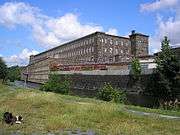Listed buildings in Brierfield, Lancashire
Brierfield is a small town and civil parish in Pendle, Lancashire, England. It contains seven listed buildings that are recorded in the National Heritage List for England. All of the listed buildings are designated at Grade II, the lowest of the three grades, which is applied to "buildings of national importance and special interest".[1] The listed buildings are varied in type, consisting of a house, two religious buildings, a bridge over the Leeds and Liverpool Canal, the Town Hall, a war memorial, and a former cotton mill.
Buildings
| Name and location | Photograph | Date | Notes |
|---|---|---|---|
| Clay Cottage 53°49′26″N 2°13′01″W / 53.82394°N 2.21705°W |
— |
18th century | A stone house with a cement tile roof in two storeys. There are two two-light sash windows in each floor, and an off-centre doorway with a chamfered surround. To the left is a modern extension.[2] |
| The Limes 53°49′27″N 2°13′10″W / 53.82412°N 2.21949°W |
 |
c. 1760 | Originally the Friends' Meeting House, it is in stone with a slate roof. There are two storeys and five bays. The square-headed windows have mullions, or mullions and transoms, and the off-centre doorway has a moulded surround.[3][4] |
| Canal bridge No 138 53°49′38″N 2°14′15″W / 53.82725°N 2.23740°W |
 |
1795 | A stone accommodation bridge over the Leeds and Liverpool Canal. It consists of a single elliptical arch with rusticated voussoirs, a plain coped parapet, and curved abutments that end in piers.[5] |
| Town Hall 53°49′28″N 2°14′02″W / 53.82455°N 2.23379°W |
 |
Mid 19th century | Originally a house, becoming the town hall in 1901 when additions were made to the front. The building is in stone with two storeys and a mansard roof. The central doorway has a three-light fanlight, and above it is a balustraded balcony on consoles. In the ground floor are two cross windows, and above are three sashes. At the top of the building is a balustraded parapet.[3][6] |
| Brierfield Methodist Church 53°49′30″N 2°14′04″W / 53.82495°N 2.23449°W |
 |
1861 | The church is in stone with a blue slate roof, and is in Italianate style. There are two storeys and four bays. The symmetrical entrance front has steps leasing up to a pair of central doorways with Doric pilasters, a triglyph frieze and a dentil cornice. The windows in the ground floor have rounded heads, and those above have segmental heads. Over these is a pediment with dentils containing an oval inscribed plaque with an edge of laurel leaves.[3][7] |
| Brierfield Mills 53°49′30″N 2°14′16″W / 53.8250°N 2.2379°W |
 |
1868 | A cotton mill in Italianate style that continued expanding until 1907. It is in stone with a roof of slate and corrugated iron. The office block has two storeys and six bays, it is pedimented, and has round-headed windows. Beside it is a ten-bay warehouse range, and behind this are other buildings, including a four-stage clock tower with a pyramidal top. Alongside the Leeds and Liverpool Canal is the spinning mill, which has four storeys and 39 bays.[8][9] |
| Brierfield Cenotaph 53°49′29″N 2°14′02″W / 53.82482°N 2.23381°W |
— |
1921 | A war memorial in the form of a cenotaph, consisting of a buttressed stone pylon on a base of two steps. Towards its top is a bronze wreath, below which is an inscribed plaque. In front of he cenotaph is a bronze sculpture of a lion. The memorial is inscribed the names of those who died in the Second Boer War and in the First and Second World Wars. The whole memorial is surrounded by decorated iron railings.[8][10] |
References
- Citations
- Sources
- Hartwell, Clare; Pevsner, Nikolaus (2009) [1969], Lancashire: North, The Buildings of England, New Haven and London: Yale University Press, ISBN 978-0-300-12667-9
- Historic England, "Clay Cottage, Brierfield (1273064)", National Heritage List for England, retrieved 28 June 2015
- Historic England, "The Limes, Brierfield (1361693)", National Heritage List for England, retrieved 28 June 2015
- Historic England, "Canal Bridge No 138, Brierfield (1243118)", National Heritage List for England, retrieved 28 June 2015
- Historic England, "Town Hall, Brierfield (1273064)", National Heritage List for England, retrieved 28 June 2015
- Historic England, "Brierfield Methodist Church (1243086)", National Heritage List for England, retrieved 28 June 2015
- Historic England, "Brierfield Mills (1073407)", National Heritage List for England, retrieved 28 June 2015
- Historic England, "Brierfield Cenotaph (1427577)", National Heritage List for England, retrieved 24 July 2015
- Historic England, Listed Buildings, retrieved 28 June 2015
This article is issued from Wikipedia - version of the 10/21/2015. The text is available under the Creative Commons Attribution/Share Alike but additional terms may apply for the media files.